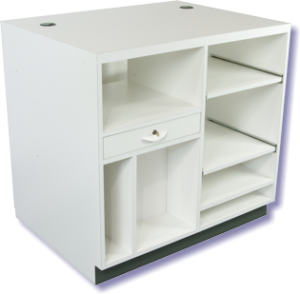 The cash wrap is the business center of your store. It's where you make sales, so it needs to be secure and efficient. But it's also where you can encourage additional sales as customers check out, so you want some space to inspire impulse purchases.
The cash wrap is the business center of your store. It's where you make sales, so it needs to be secure and efficient. But it's also where you can encourage additional sales as customers check out, so you want some space to inspire impulse purchases.
You can design your cash wrap almost any way you want, which means you can create a space that accommodates all your functional needs and perfectly matches the look and atmosphere of your store. No wonder the cash wrap is considered to be the signature fixture in most retail environments.
Here's how to choose the right cash wrap for your store.
Start by Asking Yourself These Questions
- What shape do you want? That depends, in part, on the size and shape of your retail store and the location of your cash wrap.
- How much space do you need? That depends on what activities take place at the cash wrap.
- Do you need two registers?
- Do you sell merchandise that needs to be wrapped as well as bagged? You’ll need extra space for that.
Once you figure out what your needs are, our design experts at Palmer can help you decide what style of cash wrap will be most effective for your retail business.
Designing a Space that Meets All Your Needs
Cash wraps can be right near your entrance to serve as a greeting station and a pay-and-package area. More commonly, though, they’re placed near the front of the store but far enough from the entrance to enable customers to comfortably step inside and move around before arriving at the counter.
There are three basic cash wrap configurations:
- A single countertop or cabinet surface placed parallel or perpendicular to the wall or as a free-standing “island.”
- A two-part unit — one section parallel to the wall and another free-standing unit placed in front, facing the customer.
- Three-part design that encloses the two-part unit on one side, creating a horseshoe.
Two or three-sided configurations are best if you need more than one payment station, and a U-shape improves security by restricting access behind the counter. Counters are usually 30”–36” deep. Cash wraps designed with parallel counters should provide at least three feet of space between them, so employees have room to move around, bend over to access cabinets, etc. This minimum distance also meets Americans with Disabilities Act standards.
You need enough room on the cash counter to hold at least your cash register or computer and your customer’s purchases. Allow at least 2-1/2 to 3 feet of counter length just for customers. If there isn’t enough room for all their selections, they may feel like they’re purchasing too much, whereas larger space may subtly tell them there’s room to buy more. Do not use the counter space intended for customers to set their items down for your own tasks such as wrapping.
No matter the shape you choose for your cash wrap, you’ll also want a cabinet with drawers and shelving — and doors to enclose them — to keep extra supplies handy but out of sight. Recessed top shelves are useful for hiding electrical cords, and adjustable shelves are handy for holding hangers, returned merchandise, or wrapping supplies and bags.
Finally, don’t forget to include space to display one or two small impulse-buy items and sign-up cards for your email list. You may also want to incorporate a small digital sign or kiosk, so customers can watch a short promotional video or new merchandise photos while you’re completing their transaction.
With the right cash wrap shape and functional details, your employees can serve customers smoothly and efficiently while engaging in a final personal interaction, sending them on their way with a smile.
